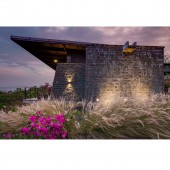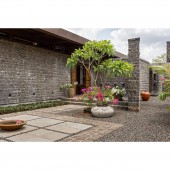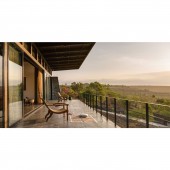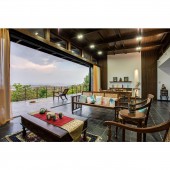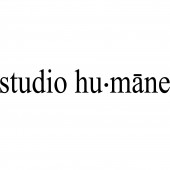Hermitage Retreat Recreational Home by Sunil Hu'mane |
Home > Winners > #58987 |
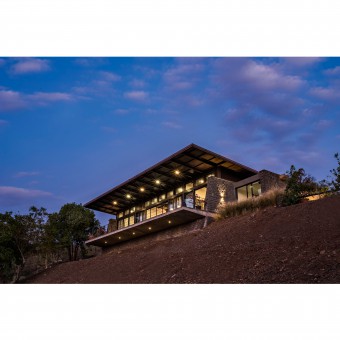 |
|
||||
| DESIGN DETAILS | |||||
| DESIGN NAME: Hermitage Retreat PRIMARY FUNCTION: Recreational Home INSPIRATION: The major inspirations, drove the project are - scenic environment around the site and the childhood memories of the client associated with their idea of 'Home'. As the client belongs to an Aristocratic family from Maratha Empire, we had thought of making it serene and subtly rich space. This leads us to our material palette as well as planning strategies. And henceforth the design is a linear open plan with a dynamic form made of sturdy stone walls and enliven by traditional elements. UNIQUE PROPERTIES / PROJECT DESCRIPTION: The house is a compact composition of intricately detailed spatial experiences, a contemporary interpretation of vernacular domains. The design is an effort towards urban regionalism and going back to our roots. The site on a hillock with panoramic views of the mountains has a crucial terrain. The House is self-sustaining structure, does not require any external energy as it is designed precisely to be able to survive on natural energy resources with minimal intervention. OPERATION / FLOW / INTERACTION: A simple and linear floor plan kept on the highest point of the site allows its user to have a continuous exposure to the beautiful view of mountains. The long deck attached to both bedrooms and living/dining space acts as a threshold between nature and man. The edge to edge openings keep the house naturally ventilated and lighted. The cautiously planned toilet courtyard makes one enjoy his solitude and act as a space to think. The entrance court provides the nostalgia of their old 'wadas'. PROJECT DURATION AND LOCATION: The construction work began on the site in 2013 and the house was completed in a holistic sense by November 2016. The project site is located in the outskirts of the metropolitan city of Pune, India within the Sahyadri mountain ranges in a picturesque setting. FITS BEST INTO CATEGORY: Architecture, Building and Structure Design |
PRODUCTION / REALIZATION TECHNOLOGY: The structural system is of a composite nature reflecting the sincerity of each material used. The material palette consists of form finished concrete, local basalt stone, Kadappah stone and teak wood. It consists of load bearing composite walls, Steel column and roof and RCC cantilevered deck. The courses of ashlar masonry have been intricately designed with due projections on the facade to create dynamism through shade and shadows. The dark stone is contrasted by the warmth of teak wood furniture and colorful upholstery and art collection of the client. SPECIFICATIONS / TECHNICAL PROPERTIES: Total Site Area : 4000 square meters Built-Up Area : 278 square meters Total Cost : 124000 USD TAGS: Recreational Space, Urban Regionalism, Neo-vernacular language, Innovative Structural System, Traditional Elements RESEARCH ABSTRACT: The objective was to study the regional vernacular architecture and to address it we did personal surveys by visiting 3-4 villages situated around the site. Detail documentation of few buildings had been done manually to understand the details, characteristics of materials and proportions of the spaces. It also brought us near to the symbols and patterns pre-dominantly used as a notion of culture there. The information collected from these villages then channelized and an architectural language had been evaluated which had a blend of modern technology and traditional materials and techniques. CHALLENGE: The challenge was to build with minimum intervention to the natural ecosystem of the site. Hence, the building was placed on the moreover flat portion of the sloping site with optimum cutting and filling. Designing this house to match with the imagery in the minds of the clients, considering their personal associations and memories was another interesting challenge, which was resolved by creating a contemporary architectural expression, still rooted deeply in the past. ADDED DATE: 2017-07-17 05:35:37 TEAM MEMBERS (3) : Landscape Architect: Ar. Shruti Humane, Structural Consultant: Sunil Mutalik and Civil Engineer: Nitin Mazire IMAGE CREDITS: Image #1: Photographer Hemant Patil, 2016 Image #2: Photographer Hemant Patil, 2016 Image #3: Photographer Hemant Patil, 2016 Image #4: Photographer Hemant Patil, 2016 Image #5: Photographer Hemant Patil, 2016 |
||||
| Visit the following page to learn more: https://bit.ly/2J7PUZ3 | |||||
| AWARD DETAILS | |
 |
Hermitage Retreat Recreational Home by Sunil Hu'mane is Winner in Architecture, Building and Structure Design Category, 2017 - 2018.· Read the interview with designer Sunil Hu'mane for design Hermitage Retreat here.· Press Members: Login or Register to request an exclusive interview with Sunil Hu'mane. · Click here to register inorder to view the profile and other works by Sunil Hu'mane. |
| SOCIAL |
| + Add to Likes / Favorites | Send to My Email | Comment | Testimonials | View Press-Release | Press Kit |
Did you like Sunil Hu'mane's Architecture Design?
You will most likely enjoy other award winning architecture design as well.
Click here to view more Award Winning Architecture Design.


